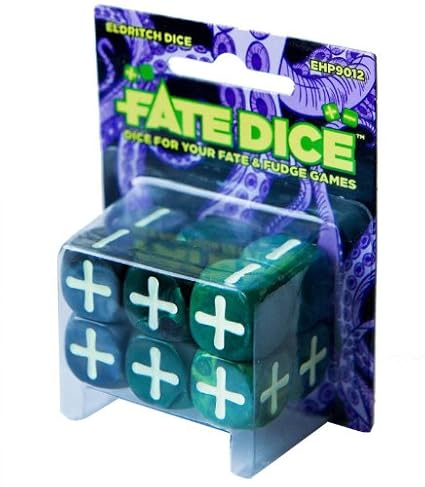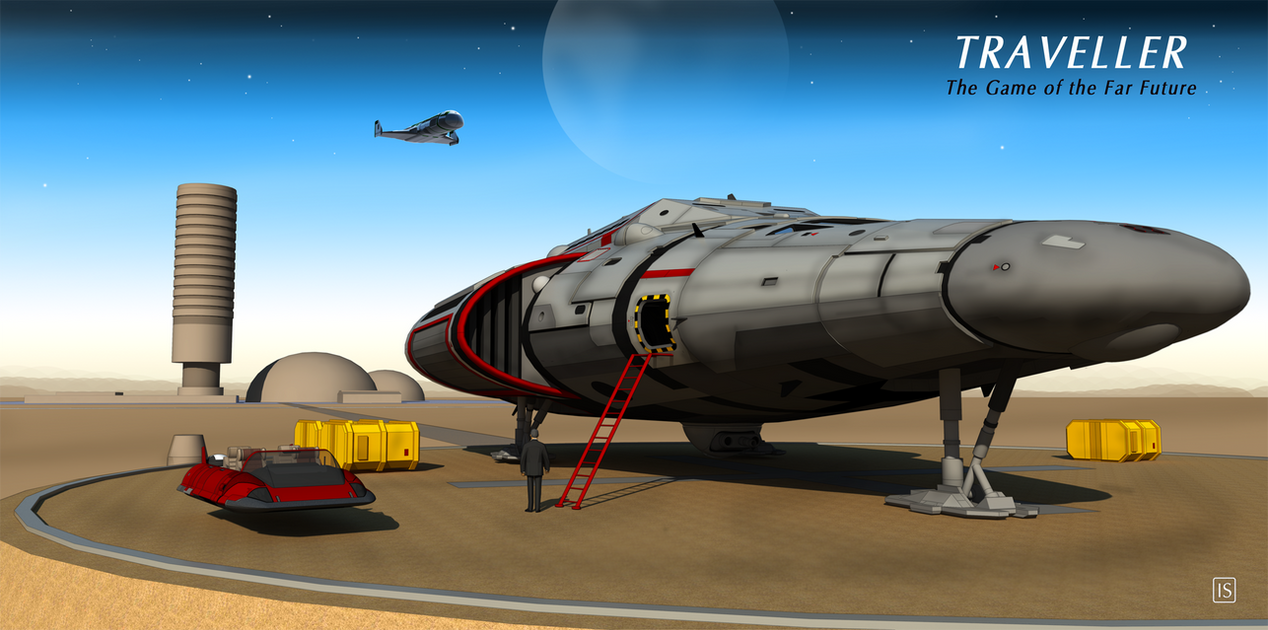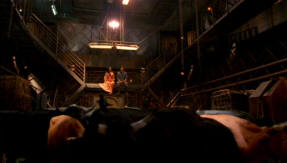Caveat Emptor: These are scribbled notes that I made on a train ride into work. No playtesters have been harmed in the creation of this system, nor have any playtesters even been contacted. And yes, hard trade and money can be handled through Aspects, but I figured I'd write it down anyway if ever a full Traveller's Fate game made it out of my head. Feel free to use this hack and let me know how it works for you.
Q Notation
As a quick refresher on Q rolls, you need 4dF made up of 2 pairs of dice in 2 different colors. Pick a pair to be your "shorter" axis. Roll 'em.

| Notation | Meaning |
|---|---|
| dF | Fudge Die (-, 0, +) |
| dT | Tally Die (0, 1, 2) |
| QF | 4dF (-4 to +4) |
| qF | 2dF (-2 to +2) |
| QT | 4dT (0 to 8) |
| qT | 2dT (0 to 4) |
Cargo For Sale
Since we're talking about Fate here, I'm not going to spend time making a list of possible trade goods. I don't know if Whale Oil or Supercomputer Components are the cutting edge tech of your world, so I'll leave the determination of goods in your capable hands. I'm basing this system on Classic Traveller, which has a d66 table giving 36 different cargo possibilities. That may be a little extreme for your particular game, but it's my starting point.
Let's assume you have the following:
- A party of characters with the interest and means (capital, cargo capacity, ability to travel) to trade.
- The willingness to entertain your players' whims as they dream of growing rich with a single devastatingly profitable sale.
- Populated locations in your world where merchants are available to trade with the characters in hopes of making a profit.
- An idea of what specific cargoes might be available, and what the base market price is for each.
I'm not going to get into the nuances of taxes, tariffs, merchant licenses, mandatory guild dues, imposing the "Call me Lefty" consequence on characters who swindle honest businessmen, nor maintenance of cargo vehicles. These are all filed under "The Cost of Doing Business", and can be used to spin stories, intrigues, and side plots from a simple trading mission.
1st Roll: Availability
Let's assume your characters are trying to purchase a cargo. Let's further assume they know where to go shopping for cargo and have all their paperwork squared away so they can go shopping for cargo. We need to determine what today's market has to offer.
QT = Amount of cargo available.
qF = Quality of cargo.
Use suitable units for your cargo. Bushels of wheat might make sense in a medieval setting, though ounces, crates, bags, or tons might make sense depending on the cargo. Multiply the amount by a logical constant, especially if it's a common cargo for the region. Merchants may be selling QTx10 bushels of wheat at harvest time, for example.
The quality of a cargo is open to interpretation, but I'd say the base value of the cargo is altered by 10% per +/-. So if your qF roll is +1, you've got a quality good here and the base value goes up by 10%. Additionally, you could create one Aspect on the cargo per +/-1, if it makes sense. If you want a wider range of qualities, use QF and make the quantity qT.
2nd Roll: Price
The first roll describes the available cargo. This second roll explores the mindset of the merchant selling the cargo.
QT = Swing, or maximum haggling potential.
qF = Base price adjustment.
Again, I'd say the base price adjustment should be 10% per +/-, though you could go 5% if you want a narrower range, or 20% if you want wider. This is purely abstract price fluctuation based on availability, market volatility, and the merchant's greed. Any one of those gives a springboard for a side story, or at least another descriptive piece of the setting.
Swing is the merchant's willingness to haggle, in 5% (or 10%) increments. This can be reduced based on how well the characters treat the merchant and how far the merchant comes down in price. If Swing reaches zero the merchant will stand firm on the price and not haggle further. If you're using a Broker, Haggle, or Merchant skill and want to handwave the negotiations, roll your skill and the positive result x 5% (or 10%?) is how much you've lowered the price.
Use a second Price roll when selling to see what the market will offer and how much they're willing to negotiate. Hopefully the players have done their research and know where their cargo is in demand, thus raising the base price at the market.
EXAMPLE: Bospor Market
The mostly-desert planet Bospor has three major exports: Chromium, Orange Diamonds, and an organic ballistic textile called Cactus Cloth. Our characters have a free trader and 50 tons of cargo space to spare, so they hit the market.
Chromium (1000 Cr/ton)
Roll 1: 6/+2 = 60 tons of extremely pure Chromium available for 1200 Cr/ton.
Roll 2: 0/+0 = Prices are governmentally mandated. This is a dictatorship, after all.
Orange Diamonds (100,000 Cr/vial)
Roll 1: 4/+1 = 4 vials of 20 fine orange stones each available for 110 kCr/vial. Has the aspect "Optical Quality".
Roll 2: 2/-2 = The nervous woman offers them for 90 kCr per vial, and will quickly drop to 70 kCr to sell them quickly. These are probably stolen.
Cactus Cloth (100 Cr/ton)
Roll 1: 3/-1 = 30 tons of factory seconds available for 90 Cr/ton. Has the aspect "Loudly Colored".
Roll 2: 4/-2 = The factory mixed different colored fibers from different regions in a vain attempt to make a vibrant plaid. Offered for 80 Cr/ton, but will drop to 60 Cr/ton to get rid of it at cost.
Notes
I figured the diamonds are more volatile since most of them are smuggled off-world anyway, so I went with 10% increments on the pricing rolls. The Cactus Cloth market rules local industry, so more stable 5% increments made sense to me.
Now I have visions of a frugal mercenary company outfitted with extremely loud Cloth armor. Thanks, random dice rolls!
Summary
qF = Quality of cargo.
Use suitable units for your cargo. Bushels of wheat might make sense in a medieval setting, though ounces, crates, bags, or tons might make sense depending on the cargo. Multiply the amount by a logical constant, especially if it's a common cargo for the region. Merchants may be selling QTx10 bushels of wheat at harvest time, for example.
The quality of a cargo is open to interpretation, but I'd say the base value of the cargo is altered by 10% per +/-. So if your qF roll is +1, you've got a quality good here and the base value goes up by 10%. Additionally, you could create one Aspect on the cargo per +/-1, if it makes sense. If you want a wider range of qualities, use QF and make the quantity qT.
2nd Roll: Price
The first roll describes the available cargo. This second roll explores the mindset of the merchant selling the cargo.
QT = Swing, or maximum haggling potential.
qF = Base price adjustment.
Again, I'd say the base price adjustment should be 10% per +/-, though you could go 5% if you want a narrower range, or 20% if you want wider. This is purely abstract price fluctuation based on availability, market volatility, and the merchant's greed. Any one of those gives a springboard for a side story, or at least another descriptive piece of the setting.
Swing is the merchant's willingness to haggle, in 5% (or 10%) increments. This can be reduced based on how well the characters treat the merchant and how far the merchant comes down in price. If Swing reaches zero the merchant will stand firm on the price and not haggle further. If you're using a Broker, Haggle, or Merchant skill and want to handwave the negotiations, roll your skill and the positive result x 5% (or 10%?) is how much you've lowered the price.
Use a second Price roll when selling to see what the market will offer and how much they're willing to negotiate. Hopefully the players have done their research and know where their cargo is in demand, thus raising the base price at the market.
 |
| Art by +Ian Stead, Available at Deviant Art. |
The mostly-desert planet Bospor has three major exports: Chromium, Orange Diamonds, and an organic ballistic textile called Cactus Cloth. Our characters have a free trader and 50 tons of cargo space to spare, so they hit the market.
Chromium (1000 Cr/ton)
Roll 1: 6/+2 = 60 tons of extremely pure Chromium available for 1200 Cr/ton.
Roll 2: 0/+0 = Prices are governmentally mandated. This is a dictatorship, after all.
Orange Diamonds (100,000 Cr/vial)
Roll 1: 4/+1 = 4 vials of 20 fine orange stones each available for 110 kCr/vial. Has the aspect "Optical Quality".
Roll 2: 2/-2 = The nervous woman offers them for 90 kCr per vial, and will quickly drop to 70 kCr to sell them quickly. These are probably stolen.
Cactus Cloth (100 Cr/ton)
Roll 1: 3/-1 = 30 tons of factory seconds available for 90 Cr/ton. Has the aspect "Loudly Colored".
Roll 2: 4/-2 = The factory mixed different colored fibers from different regions in a vain attempt to make a vibrant plaid. Offered for 80 Cr/ton, but will drop to 60 Cr/ton to get rid of it at cost.
| Shiiiiny. |
Notes
I figured the diamonds are more volatile since most of them are smuggled off-world anyway, so I went with 10% increments on the pricing rolls. The Cactus Cloth market rules local industry, so more stable 5% increments made sense to me.
Now I have visions of a frugal mercenary company outfitted with extremely loud Cloth armor. Thanks, random dice rolls!
Summary
- Determine List of Cargoes Available.
- Roll Availability: QT for Quantity/(qF x 10%) for Quality.
- Roll Price: QT for Swing/qF for Base Price - both in 5% or 10% increments.
- Roll Trading Skill: Adjust Price by 5% or 10% per plus, to a maximum of your Swing result.
- Complete Transaction.
Please let me know if you use this system and how it worked for you.
Thanks for reading!


No comments:
Post a Comment